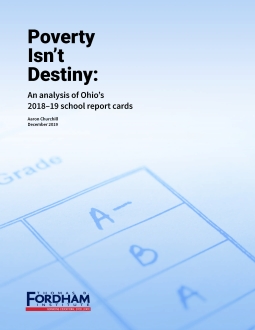Since 2005, the Thomas B. Fordham Institute has published annual analyses of Ohio’s state report cards. Based on data from the 2018-19 school year, this year’s edition contains an explanation of the report card system and an overview of the results, with a special focus on Ohio’s high-poverty urban areas and districts overseen by the state’s Academic Distress Commissions.
The main findings include:
- Ohio’s current report card system includes measures of both student proficiency and growth, resulting in a generally balanced overall rating system. As a more poverty-neutral measure, growth, or “value-added” measures, give all schools a fair opportunity to earn A’s on the Progress and Gap Closing components.
- Within the Ohio Big Eight cities, 32 percent of district schools received an overall rating of a “C” or above, while 37 percent of public charter schools achieved that mark. These respectable overall ratings, along with solid report card component ratings, help these schools stand out as families and civic leaders search for quality schools in their community.
- 58 high-performing urban schools earn an “honor roll” recognition. These schools receive A’s on the state’s value-added growth rating and an overall rating of C or higher. Twenty-one of these schools are located in Columbus; 20 in Cleveland; 4 each in Akron, Dayton, and Toledo; 3 in Cincinnati; and 2 in Youngstown.
As Ohio continues debate on the design of the state report card and the policies based on it, policymakers should understand the system’s key strengths as well as the results that it yields. We encourage state and local leaders to dive in and take a closer look by downloading Poverty Isn’t Destiny: An analysis of Ohio’s 2018-19 school report cards.



